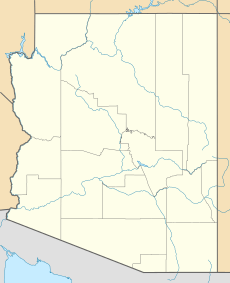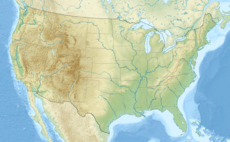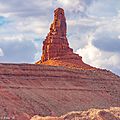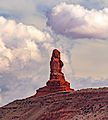Owl Rock facts for kids
Quick facts for kids Owl Rock |
|
|---|---|
| Bee 'Adizí | |
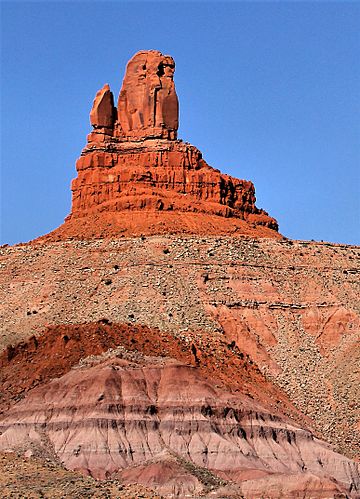
East aspect
|
|
| Highest point | |
| Elevation | 6,547 ft (1,996 m) |
| Prominence | 387 ft (118 m) |
| Isolation | 1.40 mi (2.25 km) |
| Parent peak | Agathla Peak (7,099 ft) |
| Geography | |
| Location | Navajo Reservation Navajo County, Arizona, U.S. |
| Parent range | Colorado Plateau |
| Topo map | USGS Agathla Peak |
| Geology | |
| Age of rock | Jurassic, Upper Triassic |
| Type of rock | Wingate Sandstone |
| Climbing | |
| First ascent | 1966 Fred Beckey, Harvey Carter |
| Easiest route | class 5.x climbing |
Owl Rock is a towering sandstone rock formation in northeast Arizona. It stands about 6,547 feet (1,996 meters) tall. You can find it south of Monument Valley, on land belonging to the Navajo Nation.
This amazing rock is about 7 miles (11 km) north of Kayenta. It sits on the eastern edge of Tyende Mesa, rising about 1,000 feet (300 meters) above the land around it. You can even spot it from Highway 163! Its closest tall neighbor is Agathla Peak, just 1.4 miles (2.3 km) away, across the highway. Rainwater flowing off Owl Rock eventually makes its way to the San Juan River.
The first time someone successfully climbed Owl Rock was in April 1966. Two climbers, Fred Beckey and Harvey Carter, made the climb. They used special climbing tools like pitons and bolts to get to the top. They called their climbing path Warpath.
The name "Owl Rock" comes from how much it looks like an owl when you see it from the east. In the Navajo language, it's called Bee 'Adizí, which means "spindle". For the Navajo people, this sacred place is thought to be a spindle left behind by the Holy People. A newer Navajo name for it is Tsé Ts'óózí, meaning "Slim Rock".
It's important not to confuse this Owl Rock with another one located in Arches National Park in Utah.
What is Owl Rock Made Of?
Owl Rock is a red, pointed rock made of Jurassic Wingate Sandstone. This type of sandstone is hard and fine-grained, which makes it good for rock climbing. This is different from the towers and buttes in nearby Monument Valley, which are made of a different kind of sandstone called de Chelly sandstone.
Owl Rock stands on top of Tyende Mesa. This mesa is formed from the Triassic Chinle Formation. The upper part of the mesa is made of something called the Owl Rock Member of the Chinle Formation. This part has layers of cherty limestone and limestone conglomerate mixed with claystone, mudstone, and siltstone. Below it is the Petrified Forest Member.
The Owl Rock Member is best seen at its type locality, which is near the bottom of Owl Rock itself. Here, the limestone layers stick out like ledges, helping to protect the softer rock underneath from erosion. These limestone layers are very strong against erosion. The Owl Rock Member is usually between 120 and 166 feet (37 to 51 meters) thick. At Owl Rock, it's about 166 feet (51 meters) thick.
Weather at Owl Rock
The best times to visit Owl Rock are in the spring and fall. The area has a semi-arid climate, which means it has cold winters and hot summers.
In summer, temperatures often go above 90°F (32°C), and it can get over 100°F (38°C) sometimes. But the nights are usually cool, and temperatures drop quickly after the sun sets. Winters are cold, but daytime temperatures are usually above freezing. It's rare for temperatures to drop below 0°F (-18°C), but it can happen. This desert area gets less than 10 inches (250 mm) of rain each year, and snowfall in winter is usually light.
Images for kids
-
Owl Rock (left), Highway 163, Agathla Peak from the south


